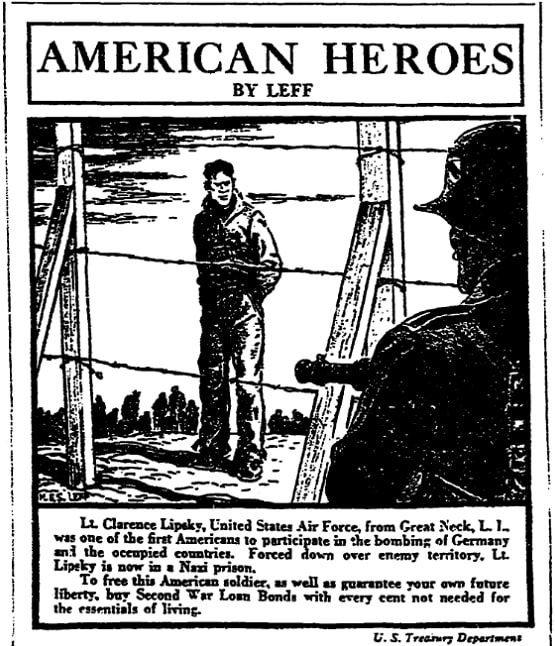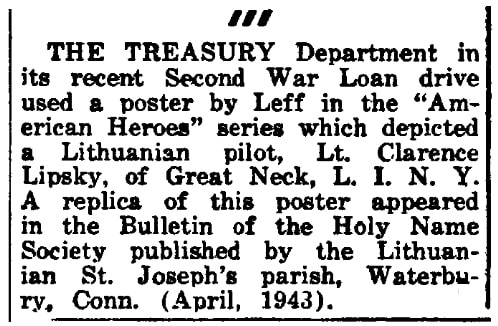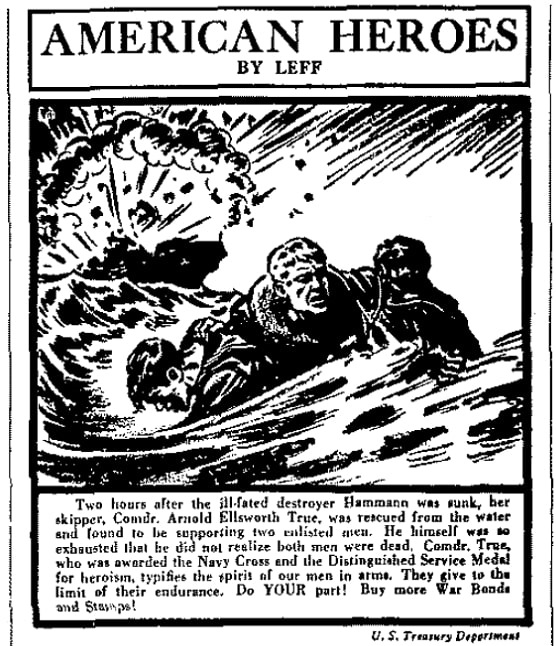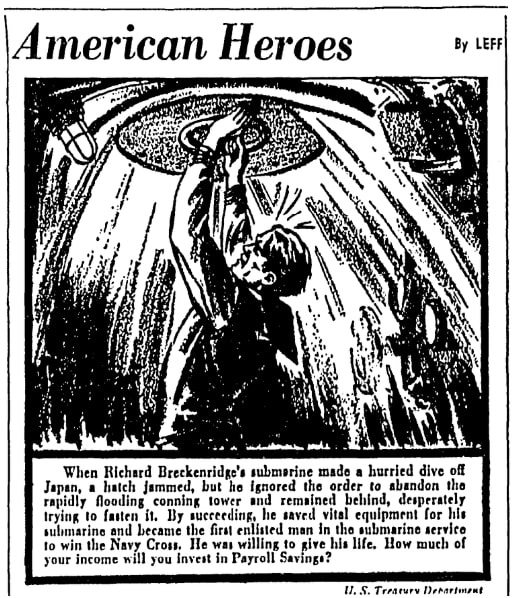Introduction: In this article, Gena Philibert-Ortega discovers that the WWII heroes depicted in comics she found in old newspapers were based on real people with amazing stories. Gena is a genealogist and author of the book “From the Family Kitchen.”
Some of my favorite finds are those that appear when I’m looking for something else in GenealogyBank’s Historical Newspaper Archives. A recent find is a series of one-panel comic illustrations appearing in 1940s newspapers called “American Heroes” by Moe and Stan Leff. I was curious about these “comics” and whether the men they depicted were real, so I decided to explore further.
American Heroes
I started my research by examining individual American Heroes comics. The first one I found told the story of Lt. Clarence Lipsky, who was a POW. His story was accented with the request that readers do their part for the war effort:
“To free this American soldier, as well as guarantee your own future liberty, buy Second War Loan Bonds with every cent not needed for the essentials of living.”

I discovered that Lt. Clarence Lipsky was real – in fact, they all were. The American Air Museum in Britain hosts a page with more information on Lt. Lipsky, including his service and where he was held as a POW. Interestingly enough, another newspaper article published in a Lithuanian American newspaper, Dirva, mentions the American Heroes series and Lt Lipsky’s appearance in it.

Genealogy Tip: Don’t forget that GenealogyBank’s ethnic, bilingual, and foreign-language newspapers can hold valuable clues.
These stories illustrated in American Heroes include the names of living and dead heroes. This panel from the Omaha Star depicts the heroics of Commander Arnold Ellsworth True, who commanded the USS Hammann that was sunk in the Battle of Midway.

The message accompanying the story of True’s efforts to save two of his men, not knowing they were dead, was:
“Do YOUR Part! Buy more War Bonds and Stamps!”
These comics were propaganda pieces spreading the message that if American soldiers were willing to risk their lives and die, the civilian population could at least buy war bonds. Heroics depicted included risking their life in hand-to-hand combat, as well as defying commands in order to save others. This comic about Richard Breckenridge describes his successful efforts to unjam a submarine hatch. According to the comic he was the first enlisted man in the submarine service to receive the Navy Cross.

According to the website The Hall of Valor Project, Breckenridge’s Navy Cross was awarded:
“For extraordinary heroism in the line of his profession while manning his battle station on the U.S.S. CUTTLEFISH (SS-171), during the highly successful and aggressive THIRD War Patrol of that submarine that resulted in the sinking of 29,600 tons of enemy shipping. On or about 27 August 1942, when the submarine was required to make a quick dive to escape destruction, the conning tower hatch wheel jammed, making it impossible to close the hatch. The Commanding Officer then ordered the conning tower abandoned, all hands except him [Breckenridge] dropping down into the control room. With the lower conning tower hatch closed and with water coming through the upper hatch, he coolly remained at his station and by his skill and determination succeeded in freeing the hand-wheel and securing the hatch before flooding of the conning tower reached the floor plates. By this act of heroism valuable instruments were saved and the submarine was able to continue on a successful patrol.” (1)
The message accompanying Breckenridge’s strip was:
“He was willing to give his life. How much of your income will you invest in Payroll Savings?”
The Story behind the Strip
So, what is the story behind these “comics”? A search on Google Books found a few mentions of the strip, including one in the 1 September 1944 issue of Minute Men, published by the U.S. Treasury War Finance Division. It explained:
“The regular press features which are mailed to daily and weekly newspapers will continue. Local WFC members can contact their local papers, urging them to include these features regularly, as to insure their greatest possible appearance in the nation’s press.”
It also explained that:
“American Heroes, sent once weekly to 3,539 papers, consists of descriptions and drawings (donated by syndicate artist Moe Leff) based on valor citations issued by the Army and Navy.” (2)
Author and comic strip historian Allan Holtz writes that American Heroes was mostly likely started by brothers Moe and Stan Leff. Later it was drawn by Julian Ollendorff, and lastly by Woody Cowan. The strip existed from 1943 to 1945. (3)
American Heroes is a great example of how information about real people doesn’t just get published in newspaper articles. Newspapers also published factual-based comics that told ancestral stories.
Explore over 330 years of newspapers and historical records in GenealogyBank. Discover your family story! Start a 7-Day Free Trial.
Note on the header image: an “American Heroes” comic strip by Moe and Stan Leff published during World War II.
____________________
(1) “Richard F. Breckinridge, The Hall of Valor Project (https://valor.militarytimes.com/hero/19839: accessed 29 October 2022.
(2) Minute Man. United States, U.S. Government Printing Office, 1944, p. 10. Available at Google Books: https://www.google.com/books/edition/Minute_Man/M_5LAQAAIAAJ?hl=en&gbpv=1&dq=%22american+heroes%22+leff&pg=RA1-PA10&printsec=frontcover
(3) “Selling It: American Heroes,” Stripper’s Guide (http://strippersguide.blogspot.com/2022/01/selling-it-american-heroes.html: accessed 29 October 2022).
